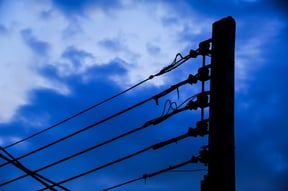NESC Encyclopedia: G for Greater Than, H for Head to Next Pole
 From first sight to final inspection, utility pole inspection is a vital part of successful field asset verification. So what really happens out there during assessment of equipment? In this issue, we finish out the chain of inspection events, taking a look at the final two measurements a technician will take during a utility pole inspection—and the minimum amount of space between lines that must exist—then say farewell to the pole, and our series.
From first sight to final inspection, utility pole inspection is a vital part of successful field asset verification. So what really happens out there during assessment of equipment? In this issue, we finish out the chain of inspection events, taking a look at the final two measurements a technician will take during a utility pole inspection—and the minimum amount of space between lines that must exist—then say farewell to the pole, and our series.
Space Matters
Many NESC mandates address the minimum requirements for safe working space—that is, the space between the lowest communication line and the power neutral. Two final designations that must be "greater than" a specific measurement are the distance between mid-span lines and between communication drop lines that run parallel to one another.
30 inches is the rule for mid-span lines. This covers lines running horizontally from pole to pole, measured at the mid-span—i.e. the point at which the cable sags the most.
12 inches is enough space between parallel drop lines. Once the technician has measured mid-span lines, they will check the distance between communication drop lines running parallel to power drop lines. In contrast to the 30 inches required of mid-span lines, drop lines only need to be 12 inches apart.
Why is having a set distance between lines and drops important? As usual, safety. Lines that come too close together could be in danger of touching—and arcing dangerous voltage between them. This presents an obvious safety concern to technicians in the field, as well as the public. As one of our technicians put it when asked what could happen if spacing between lines is not sufficient: "Danger, Will Robinson. Danger."
The End of the Line
Line measurements are among the last things on a technician’s list when wrapping up a utility pole inspection. What’s left before signing off on another pole? A final visual inspection to ensure nothing was missed and a careful double-check of information entered. Diligence is of the essence, as documented by one of Alden’s field inventory experts: "Before moving on, I always look back over everything I’ve input, particularly in urban areas where you may have many drops going many different places, many of them in violation." The technician can then close the book on that asset for now, and move on to the next, starting at letter A all over again.
By the end of a utility pole inspection, a lot has been accomplished. The sum total of an inventory should be a full picture of what the owner has in the field—a valuable collection of data that can help guide your business to action. Your action plan should include making repairs, future maintenance planning, and ensuring assets are performing, generating revenue and keeping your information and services moving along.
Like most businesses, utilities spend a large amount of time trying to figure out ways to save both time and money. These two objectives can often be achieved by simply increasing efficiency, which equals a rise in productivity. A thorough, well-documented utility pole inspection by an experienced provider does both, increasing organizational effectiveness—and the bottom line—if the data collected is used proactively, to drive an efficient asset management program. The eight steps in the encyclopedia of utility pole inspection get you there. The final word: It’s what you do with your data that really counts.

Comments